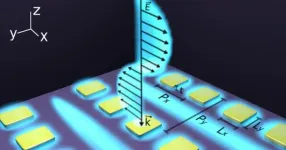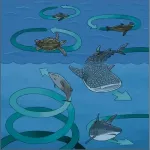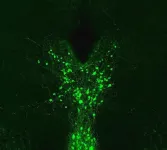Light it up: uOttawa researchers demonstrate practical metal nanostructures
2021-03-18
(Press-News.org) Researchers at the University of Ottawa have debunked the decade-old myth of metals being useless in photonics - the science and technology of light - with their findings, recently published in Nature Communications, expected to lead to many applications in the field of nanophotonics.
"We broke the record for the resonance quality factor (Q-factor) of a periodic array of metal nanoparticles by one order of magnitude compared to previous reports," said senior author Dr. Ksenia Dolgaleva, Canada Research Chair in Integrated Photonics (Tier 2) and Associate Professor in the School of Electrical Engineering and Computer Science (EECS) at the University of Ottawa.
"It is a well-known fact that metals are very lossy when they interact with light, which means they cause the dissipation of electrical energy. The high losses compromise their use in optics and photonics. We demonstrated ultra-high-Q resonances in a metasurface (an artificially structured surface) comprised of an array of metal nanoparticles embedded inside a flat glass substrate. These resonances can be used for efficient light manipulating and enhanced light-matter interaction, showing metals are useful in photonics."
"In previous works, researchers attempted to mitigate the adverse effect of losses to access favorable properties of metal nanoparticle arrays," observed the co-lead author of the study Md Saad Bin-Alam, a uOttawa doctoral student in EECS.
"However, their attempts did not provide a significant improvement in the quality factors of the resonances of the arrays. We implemented a combination of techniques rather than a single approach and obtained an order-of-magnitude improvement demonstrating a metal nanoparticle array (metasurface) with a record-high quality factor."
According to the researchers, structured surfaces - also called metasurfaces - have very promising prospects in a variety of nanophotonic applications that can never be explored using traditional natural bulk materials. Sensors, nanolasers, light beam shaping and steering are just a few examples of the many applications.
"Metasurfaces made of noble metal nanoparticles - gold or silver for instance - possess some unique benefits over non-metallic nanoparticles. They can confine and control light in a nanoscale volume that is less than one quarter of the wavelength of light (less than 100 nm, while the width of a hair is over 10 000 nm)," explained Md Saad Bin-Alam.
"Interestingly, unlike in non-metallic nanoparticles, the light is not confined or trapped inside the metal nanoparticles but is concentrated close to their surface. This phenomenon is scientifically called 'localized surface plasmon resonances (LSPRs)'. This feature gives a great superiority to metal nanoparticles compared to their dielectric counterparts, because one could exploit such surface resonances to detect bio-organisms or molecules in medicine or chemistry. Also, such surface resonances could be used as the feedback mechanism necessary for laser gain. In such a way, one can realize a nanoscale tiny laser that can be adopted in many future nanophotonic applications, like light detection and ranging (LiDAR) for the far-field object detection."
According to the researchers, the efficiency of these applications depends on the resonant Q-factors.
"Unfortunately, due to the high 'absorptive' and 'radiative' loss in metal nanoparticles, the LSPRs Q-factors are very low," said co-lead author Dr. Orad Reshef, a postdoctoral fellow in the Department of Physics at the University of Ottawa.
"More than a decade ago, researchers found a way to mitigate the dissipative loss by carefully arranging the nanoparticles in a lattice. From such 'surface lattice' manipulation, a new 'surface lattice resonance (SLR)' emerges with suppressed losses. Until our work, the maximum Q-factors reported in SLRs was around a few hundred. Although such early reported SLRs were better than the low-Q LSPRs, they were still not very impressive for efficient applications. It led to the myth that metals are not useful for practical applications."
A myth that the group was able to deconstruct during its work at the University of Ottawa's Advanced Research Complex between 2017 and 2020.
"At first, we performed numerical modelling of a gold nanoparticle metasurface and were surprised to obtain quality factors of several thousand," said Md Saad Bin-Alam, who primarily designed the metasurface structure.
"This value has never been reported experimentally, and we decided to analyze why and to attempt an experimental demonstration of such a high Q. We observed a very high-Q SLR of value nearly 2400, that is at least 10 times larger than the largest SLRs Q reported earlier."
A discovery that made them realize that there's still a lot to learn about metals.
"Our research proved that we are still far from knowing all the hidden mysteries of metal (plasmonic) nanostructures," concluded Dr. Orad Reshef, who fabricated the metasurface sample. "Our work has debunked a decade-long myth that such structures are not suitable for real-life optical applications due to the high losses. We demonstrated that, by properly engineering the nanostructure and carefully conducting an experiment, one can improve the result significantly."
INFORMATION:
The paper END
[Attachments] See images for this press release:

ELSE PRESS RELEASES FROM THIS DATE:
2021-03-18
Medical cannabis is a subject of much debate. There is still a lot we do not know about cannabis, but researchers from the Department of Neuroscience at the Faculty of Health and Medical Sciences have made a new discovery that may prove vital to future research into and treatment with medical cannabis.
Cannabinoids are compounds found in cannabis and in the central nervous system. Using a mouse model, the researchers have demonstrated that a specific synthetic cannabinoid (cannabinoid WIN55,212-2) reduces essential tremor by activating the support cells of the spinal cord and brain, known as astrocytes. Previous research into medical cannabis has focussed on the ...
2021-03-18
LOS ANGELES (March 18, 2021) -- COVID-19 disproportionately affects men compared with women, raising the possibility that a hormone like progesterone may improve clinical outcomes for certain hospitalized men with the disease. New research from Cedars-Sinai published online in the journal Chest supports this hypothesis.
The pilot clinical trial, involving 40 men, is believed to be the first published study to use progesterone to treat male COVID-19 patients whose lung functions have been compromised by the coronavirus. While the findings are promising, larger clinical trials are needed to establish the potential of this experimental therapy, the investigators said.
The study was prompted ...
2021-03-18
In response to the recent freeze-inspired power outages in Texas, some politicians blamed the historic blackouts on wind turbines. The dubious, and largely dismissed, claims nevertheless spotlighted an intriguing fact: Texas, the land made famous by oil derricks and wildcatters, now gets a significant portion of its electricity from clean, renewable sources, most notably wind, but also from water and solar - a troika of sustainability known collectively as WWS.
"Texas gets about 20 percent of its electricity from wind alone," says Mark Z. Jacobson, a professor of civil and environmental engineering at Stanford University and senior fellow at the Stanford Woods Institute ...
2021-03-18
Technological advances have made it possible for researchers to track the movements of large ocean-dwelling animals in three dimensions with remarkable precision in both time and space. Researchers reporting in the journal iScience on March 18 have now used this biologging technology to find that, for reasons the researchers don't yet understand, green sea turtles, sharks, penguins, and marine mammals all do something rather unusual: swimming in circles.
"We've found that a wide variety of marine megafauna showed similar circling behavior, in which animals circled consecutively at a relatively ...
2021-03-18
What The Article Says: An oncologist reflects on how advising patients with cancer about travel during a pandemic requires a nuanced consideration of benefit and risk, especially when considering lost opportunities when prognosis is limited.
Authors: Christopher E. Jensen, M.D., of the University of North Carolina School of Medicine in Chapel Hill, is the corresponding author.
To access the embargoed study: Visit our For The Media website at this link https://media.jamanetwork.com/
(doi:10.1001/jamaoncol.2021.0125)
Editor's Note: The article includes conflicts of interest disclosures. Please see the article for additional information, including other authors, author contributions and affiliations, conflict of interest and financial ...
2021-03-18
What The Study Did: Researchers examined whether state medical and recreational cannabis laws were associated with changes in rates of self-harm and assault injuries.
Authors: Keith Humphreys, Ph.D., of Stanford University in Stanford, California, is the corresponding author.
To access the embargoed study: Visit our For The Media website at this link https://media.jamanetwork.com/
(doi:10.1001/jamanetworkopen.2021.1955)
Editor's Note: Editor's Note: The article includes conflicts of interest disclosures. Please see the article for additional information, including other authors, author contributions and affiliations, conflict of interest and financial disclosures, and funding and support.
INFORMATION:
Media advisory: The full study and ...
2021-03-18
CHAPEL HILL, NC - Males and females, generally speaking, experience and respond to pain differently, but scientists have yet to understand all the brain circuits involved in these differences. Now, new research from the UNC School of Medicine lab of Thomas Kash, PhD, shows how neurons use dopamine to regulate pain differently in male and female mice.
The discovery, published in the journal Neuron, could help the scientific community devise better pain management strategies, particularly for women, who are disproportionally affected by pain throughout their lifespans.
"We focused on this neural pathway because our previous work and that of others ...
2021-03-18
Low plasma levels of protein TGFB1 and polymorphisms in gene TGFB1 act as biomarkers for the prognosis of gastric adenocarcinoma, according to a study led by the University Complutense of Madrid (UCM).
In particular, these variants are 12% more frequent in patients with metastatic tumors, "which indicates their importance in the clinical progression of this disease", stated José Manuel Martín Villa, Professor of Immunology and researcher at the Department of Immunology, Ophthalmology and Otolaryngology of the UCM.
In addition to identifying patients with poorer progression and high mortality, these markers also identify individuals at ...
2021-03-18
SAN ANTONIO -- March 18, 2021 -- Working with a team led by French astronomers, Southwest Research Institute scientists helped identify incredibly powerful winds in Jupiter's middle atmosphere for the first time. The team measured molecules exhumed by the 1994 impact of comet Shoemaker-Levy 9 to trace winds in excess of 900 miles per hour near Jupiter's poles.
Jupiter's distinctive red and white bands of swirling clouds allow scientists to track winds in the planet's lower atmosphere, and the SwRI team members have particular expertise in the vivid Jovian aurora, associated with strong winds in the gas giant's upper atmosphere. Until now, wind patterns in the cloudless stratosphere, between the two atmospheric layers, have eluded observation.
"The team of ...
2021-03-18
Mitochondria are important cellular power plants whose diminished activity has been previously demonstrated to be associated with obesity by a group of researchers at the University of Helsinki. Now, in a new international study coordinated by the University of Helsinki, the researchers have determined that the method of weight loss affects the metabolic pathways of mitochondria in fat tissue, also known as adipose tissue.
The study was recently published in the Journal of Clinical Endocrinology and Metabolism.
The researchers combined two datasets on calorie restriction diets and two datasets on weight loss surgery, or bariatric surgery, from Europe, monitoring dieters' weight loss as well as metabolism. A biopsy was taken from the study subjects' adipose tissue both at ...
LAST 30 PRESS RELEASES:
[Press-News.org] Light it up: uOttawa researchers demonstrate practical metal nanostructures



